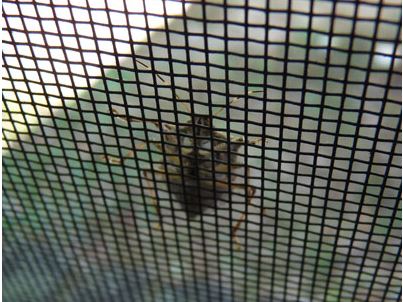 The brown, marmorated stink bug (Halyomorpha halys) is a relatively new sign of fall here in Western Pennsylvania. This stink bug is a native of northeast Asia (Japan, Korea, and China) and, apparently, is just as annoying there as it is here! Its use of human habitations as hibernation refuges, and its ability to communicate via pheromones and then aggregate in great numbers in some selected house, barn, porch, garage, or any other stink-bug-determined-suitable building makes their presence both in their native and also in their invasive regions impossible to ignore.
The brown, marmorated stink bug (Halyomorpha halys) is a relatively new sign of fall here in Western Pennsylvania. This stink bug is a native of northeast Asia (Japan, Korea, and China) and, apparently, is just as annoying there as it is here! Its use of human habitations as hibernation refuges, and its ability to communicate via pheromones and then aggregate in great numbers in some selected house, barn, porch, garage, or any other stink-bug-determined-suitable building makes their presence both in their native and also in their invasive regions impossible to ignore.
It is thought that this insect was first released into the United States in Allentown, PA in 1996. It apparently traveled from northeast Asia in a shipping container that was delivered either to the port of Philadelphia or Elizabeth, New Jersey and then trucked to Allentown. Five years later this new, alien, invasive species was recognized and identified by entomologists at Cornell University. By then large populations were being observed throughout eastern Pennsylvania, New Jersey and New York. This insect has now spread to thirty-five states primarily in the eastern United States. It has very large populations in Pennsylvania, Maryland, Virginia, New York, New Jersey, Massachusetts, Delaware, Ohio, and North and South Carolina. It has also spread to California and Oregon allegedly via a car driven by a person traveling from Pennsylvania to California in 2005.
Here in Western Pennsylvania our first massive fall outbreak of brown marmorated stink bugs was in 2010. Two of my students since then have gotten interested in the species and have done some research into their biology and ecology and even conducted some experiments to determine the species’ habitat selection preferences.
The ability of these stink bugs to overwinter is remarkable. There is some mortality among the hibernating bugs, but a significant percentage of them make it through to spring and to their opportunity to mate. Colder temperatures, though, reduce this percentage of survival. Several models of climate change and global warming have included increased survival of stink bugs at higher and higher latitudinal locations with, then, significantly larger spring and summer populations of this potentially destructive pest.
The brown marmorated stink bug feeds on over one hundred plant species including several of great economic importance to humans. Fruit trees (especially apple and pear), soybeans, and peanuts are crops significantly damaged by these insects. I have also seen adult stink bugs in my yard feeding avidly on the grapes growing on my grape vine.
Predators that feed on these stink bugs seem to be lacking in their invasive ranges. This absence of biological control agents is one of the reasons that this species has so greatly increased in numbers throughout these territories. In their native regions spiders, ants, lacewings, and several species of parasitic flies and wasps have been described to feed on these stink bugs. Some predation by birds has also been mentioned.
Some interesting observations that Deborah and I have made on our “own” stink bug populations include the leftover exoskeletons of stink bugs eaten by our basement pholcid spiders, aggressive web-spinning spiders wrapping up captured stink bugs in their silk (here’s a video of this), and a chickadee repeatedly flying up to one of our stink bug-covered house windows, grabbing one stink bug at a time and taking it off to a feeding roost to eat it. We speculate that our local predators may be becoming adapted to and aware of the growing stink bug feast around them!
Go Chickadee!!
